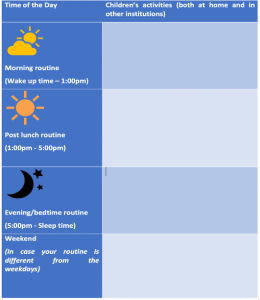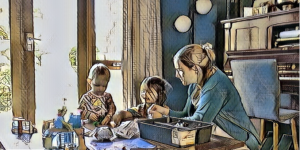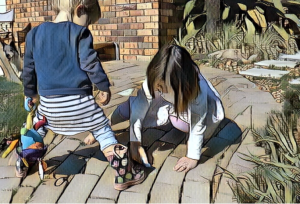Chapter 9: Conceptual PlayWorld for families: Why play works for teaching STEM in the home setting
Prabhat Rai
Chapter goals
By reading and exploring the content of this chapter, you will learn:
- how to plan a Conceptual PlayWorld for your home setting
- how to set up a Conceptual PlayWorld for STEM teaching.
Introduction
Charlotte is very worried, pacing back and forth in the staffroom. Yuwen asks Charlotte what’s bothering her. She finds out that Ella’s mother, Lily, came to meet Charlotte earlier in the day. Lily thanked Charlotte for doing magic in her class; Ella is curious about science, technology and design. Lily has heard about Conceptual PlayWorld from Ella and wants to set one up at her home to support Ella’s STEM learning. Charlotte is worried as she has never done a Conceptual PlayWorld for families. As mentioned in Chapter 1, Fleer’s Conceptual PlayWorld is an evidence-based pedagogical model that supports children’s STEM learning and imagination in their early years. Developed by Fleer (2017, 2018, 2020), the model has been created in collaboration with educators but is equally powerful in creating new motivating conditions for STEM learning in the home setting (Fleer, Fragkiadaki & Rai, 2020).
Meeting the problem
Charlotte knows how to plan a Conceptual PlayWorld for her children in the centre, but the home is a different scenario. She has not done it herself before. Her head is spinning as she considers the complexities of a Conceptual PlayWorld in the home setting:
- Apart from the usual worries of which story to choose and which concept to work with, she also thinks about the child, her siblings and other adults in the home.
- How do you develop a Conceptual PlayWorld that fits a child’s daily routine, especially when the child is so young, like Ella, who has just turned two?
- She is also unsure if her mother would like the idea of being a play partner, and on top of everything, how will she talk about science concepts?
Yuwen comes to Charlotte’s rescue. She has recently done a Conceptual PlayWorld with a family, which was a big success.
Figure 9.1.
A worried Charlotte being comforted by Yuwen.

Practice reflection: 9.1: Do you have suggestions for Charlotte? Why do you think she is finding it so challenging? Record your answers in the Fleer’s Conceptual PlayWorld thinking book.
Planning a Conceptual PlayWorld for families
Yuwen tells Charlotte that we use the same characteristics of the Conceptual PlayWorld in the home setting. However, one big difference is that you are planning for others, i.e., parents to implement it instead of the teacher. Yuwen thinks this will help Charlotte become the master trainer as she can train families to implement a Conceptual PlayWorld.
Dramatic story
Charlotte remembers Lily and Ella are reading the storybook Time for Bed by Mem Fox. However, Charlotte feels there is no drama in the book. Yuwen suggests that in a Conceptual PlayWorld, building empathy for the character and being together in the imaginary situation is key. To amplify the drama, they can add their own narrative. They can also encourage Ella and Lily to wear props that help to build the story plot. Charlotte likes the idea of reading books with props. Yuwen suggests that Lily and Ella can read the book at different times of the day and as a bedtime routine to develop familiarity with the story’s characters. She shows Charlotte one of her own treasured possessions – a sketchbook she developed while working with one of the families.
Figure 9.2.
Mother and children reading a book together. They are in character wearing their props and holding animal toys.

Knowing children’s social situation of development
Charlotte’s eyes lit up as she looked at the images from the sketchbook. She would like this to happen in children’s homes where they are happy and relaxed reading stories with their parents. While looking at the sketchbook, Yuwen realised they had not discussed the family and children’s routine. She asked Charlotte if she knew more about Ella’s everyday routine, whether she has siblings, her parents’ occupations, and other family interests. Charlotte knows from the centre’s record that Ella has an older sister, and both her parents are working. Yuwen comes up with an idea and asks her to become a teacher researcher for a while. Yuwen had a simple format to ask Lily about Ella’s daily routine so that they could plan their Conceptual PlayWorld better.
Figure 9.3.
Template for collating children’s everyday routine

Charlotte feels supported and excited about being a researcher and learning more about the family. Yuwen shared with Charlotte that they have to design a Conceptual PlayWorld for Ella’s home so that she feels supported and has space to bring her family practices to her play. A child’s interest and developmental process need to be acknowledged and used so that they are agentic in contributing to their learning. She explained to Charlotte the concept of ‘social situation of development’, which could be defined as ‘the special combination of internal developmental processes and external conditions that are typical of each developmental stage and that condition both the dynamic of mental development for the duration of the corresponding developmental period and the new qualitatively distinct psychological formations that emerge towards its end’ (Bozhovich, 2009, p.67). Yuwen simplified the ideas further and said they must acknowledge a child’s age, social environment and unique relationship with this social world to create this Conceptual PlayWorld. They have to support the child to create these new conditions for their STEM learning – they have to value their agency.
Research Readings 9.1: The following reading highlights the importance of understanding the demands created by specific institutions like home, childcare etc. on children’s everyday practice and routine.
Designing a Conceptual PlayWorld space
Charlotte comes back with information on Ella’s everyday routine and some understanding of their family values and cultural practices. She also heard from Lily that Ella is fascinated with shadows. Charlotte quickly planned so they could explore and learn the concept of light and shadow in this Conceptual PlayWorld. Yuwen could see that Charlotte was becoming confident in engaging with the concepts, and she supported her idea. They discussed how the book offers an excellent context to introduce the concept of light. The end-of-the-day bedtime routine could fit in very well with a working mother like Lily. They can read the book at night and plan a few play activities over the weekend.
Their next challenge was to create different spaces that give opportunities for exploring both concepts and give them a sense of being together in a collective imaginary situation. Being in the collective imaginary situation is so important.
Practice reflection 9.2: What do you think we should do to create a space that aligns with the story and also helps in exploring the concept of light and shadow? Can you help Charlotte create a collective imaginary situation? Record your answers in the Fleer’s Conceptual PlayWorld thinking book.
Research Readings 9.2: This reading below foregrounds imagination as one of the key psychological functions in early years. It also explores the role of collective forms of imagining in children’s concept learning.
Material conditions and Conceptual PlayWorld space
While planning a Conceptual PlayWorld we need to acknowledge the mutual constitution of the material condition and people’s subjectivity. Säljö (2019) suggests that humans can ‘convert ideas into artefacts that support intellectual and physical activities, and that later will intervene in our daily practices’ (p. 21). This dialectical relationship between artefacts and thinking is not limited to everyday objects around us but also to digital tools.
Research Readings 9.3: This paper emphasises the relational nature of tool use. It also offers evidence to show how Conceptual PlayWorlds create new conditions for children’s concept learning in their home.
Yuwen and Charlotte were excited as they received more information about the Ella’s social situation and her everyday family practices. They were mindful that children’s material conditions offer them unique experiences and they have to build their Conceptual PlayWorld plans around it. They planned to set up a dark space in the bedroom, like a tent or a cubby, which Ella and her parents could explore with torches. They can also take objects or toys of different sizes and shapes and explore shadows. Yuwen recalled an episode from Dr Binocs shows, which families can watch together for more ideas.
Yuwen suggests that once they have played in the tent/cubby, Ella can make some puppets and they can do some shadow puppet theatre. Knowing Ella, Charlotte was not sure if this was going to work. She recalls that Ella loves music, and goes to dance classes. Yuwen thinks it would be a good idea to suggest a shadow dance. This does not need any special set up – children and family members can manipulate light using their bodies on one of the walls to show different dance moves. Watch this video for some shadow dance ideas.
Charlotte: I’m delighted to imagine that Ella will have so much fun in this Conceptual PlayWorld.
Yuwen: The key is that both adults and children should have fun and play. As we design this Conceptual PlayWorld, we need to develop plots that help to explore the concept further and make it personally meaningful for Ella. Do you think if they make animal puppets, e.g. horse, cow, cat, goose, fish, deer or other characters from the story, it would help them extend the play plot?
Charlotte: Great idea! They can use various homemade animal ears or tails to add drama.
Yuwen: You are getting so good at this, Charlotte!
Practice reflection 9.3: What do you think about Yuwen and Charlotte’s plan? Do you think it will work? Write your own plan in your Fleer’s Conceptual PlayWorld thinking book.
Yuwen is reminded that, unlike usual science teaching sessions, the purpose is not to give children science facts or concepts quickly. The Conceptual PlayWorld supports exploring science concepts, so they must plan multiple ways of exploring the concept in detail. Yuwen suggests they need to plan more opportunities for children’s ideas and understandings to become more visible. Charlotte plans a ‘shadow detectives’ game where children and adults can use mobile phones or cameras to take photographs of shadows of different objects in the house and then compare their photos. They can talk about the light source, direction of light, size of the object and shadow.
They remember they had recently seen a Bluey episode on shadowlands. Charlotte thinks it would be a lovely idea to watch this episode together.
You can watch the Bluey episode yourself on the Bluey website.
Yuwen highlighted that it is so important to consider these multiple resources. Digital tools can amplify children’s experiences and add fun and drama to their play. Yuwen showed another page from her sketchbook to highlight that material conditions afford new possibilities for learning. In the picture below, children play with their mother using Lego blocks and other manipulatives.
Figure 9.4.
Mother and children playing together in the home setting

Entering and exiting the Conceptual PlayWorld
Yuwen and Charlotte plan for the family to enter the Conceptual PlayWorld, imagining they are travelling to bedtime and singing their favourite rhymes together (e.g. Twinkle Twinkle Little Star). They can pretend to put on pyjamas and pretend to wind the clock forward/backwards to enter and exit the PlayWorld playing animals putting their young to bed. All the family members are in the same imaginary situation – pretending to be in a night-time setting together. Family members can choose characters from the storybook as they enter the imaginary situation. Charlotte says that the most important point is that parents are also always a character in the story or acting as a human prop (e.g., as the goose or the cat), being part of the night-time routine, being the parent animal, pretending to be the baby animal and vice versa, inviting role reversal. They play with children and can control or direct them from inside the collective imaginary situation.
Planning the play inquiry or problem scenario
Charlotte always finds developing an authentic problem challenging. Yuwen comes to the rescue; she thinks the problem is that baby animals cannot find their shadow at night without light. They ask the children at home for help. As they get busy detailing the problem, Yuwen reminds Charlotte that the problem scenario is not scripted but a general idea of the problem is planned. They could suggest that children have received a letter from the animals: Please help us find our shadows, we are lonely, we need your help.
The other equally important aspect of developing the problem scenario is that children need to have enough knowledge to solve the problem. Several activities (shadow dance, shadow detectives or Bluey’s shadowlands) designed by Yuwen and Charlotte will help children explore the concept of light and shadow.
Yuwen: This might be a good moment for Lily to pretend to be an engineer and offer expert knowledge on light and shadow. A shadow is a dark shape that forms when an object blocks some of the light. I think we have to explain the idea in an easily understandable language. It is important to bring children’s experiences of playing shadow games here. We can detail this further. For now, the problem looks dramatic and engaging. This will motivate Ella to know more and help the animals. Being clear about the concepts that will be learned from solving the problem situation is also essential. In one of the works I did in the past, we asked children to measure their shadows at different time points of the day, and they loved the game. Do you want to see my sketchbook again?
Charlotte: I love your sketches, of course yes!
Yuwen had images of children playing a game of measuring their shadow. It was so relevant to their planning that they decided to share them with Lily so that she could get some examples.
Figure 9.5
Children drawing and measuring each other’s shadow

Yuwen thinks this will be an inspiring experience for Ella. She will be able to experience, with the help of her family, that the size and shape of shadows change depending on the light source, e.g. distance; silhouette, 3-dimensional and 2-dimensional shape, light and dark, opaque, transparent, and translucent. The key would be how to plan the adult interaction.
Planning parent’s interaction to support conceptual learning
It is evident from the activities that the concept is in ‘service of play’. Children are exploring the concept, but their play is being further enriched.
Parents are not always the same character, and their roles are not scripted. Parents might be a cow or horse and invite the child to be part of the animal family. If there is another adult or sibling, they can play a role or help to solve the problem, e.g. how to create shadows. Yuwen explains that the biggest challenge for the parents would be to take on multiple roles. They might have to prepare a bit for that. She suggests that Charlotte talk with Lily about this. They must work alongside children to solve the problem and offer expert knowledge on the science concept when the moment is right. If the child is not feeling motivated, they may have to be encouraged from inside or ask questions that could generate interest. Yuwen suggests they make a few suggestions for Lily, which might make her more confident doing this.
Charlotte: I get your point. Like me in the centre, she can be a play partner, leader or explorer. What if we label roles like that?
Yuwen thinks it is a brilliant idea, and they come up with the following plan:
- Parent as play partner – Be equal with the child, e.g. ‘Let’s work out how to create a shadow together’, playing shadowlands, holding the torch or being inside the tent with the child.
- Parent as play leader – Above position, where parents are responsible for leading the play, sharing information about light and shadow and highlighting to children what is important. It is an essential role to lead concept learning. A child would not be able to do this alone.
- Parent as play explorer – Sometimes, a parent has to work from the below position, asking questions to generate curiosity or understand the child’s experience. Kravtsov and Kravtsova (2010) use the concept of subject positioning in the context of pair pedagogy. Here, it explains the pedagogical relationship between the adult and the child. It is worth highlighting the dual positional perspective here, allowing participants to understand themselves and their social situation. So, both children and adults are the subjects of play, but they also control the play. These ideas around pedagogical positioning are also discussed in more detail in Chapter 3.
Practice reflection 9.4: Can you think of other pedagogical positionings of the adults in children’s play? Which role do you like to take? Do you think these roles differ from being the director of children’s play from outside? Record your answers in the Fleer’s Conceptual PlayWorld thinking book.
Research Readings 9.4: In the video below, a lecture by Laureate Prof. Marilyn Fleer will help you to carefully think of the role of the adult in children’s play. The argument worth considering is that parents or teachers need to be mindful of their pedagogical positionings while working with children.
Conclusion
This chapter shows how the Conceptual PlayWorld could create new motivating conditions for STEM learning in children’s home settings. Yuwen and Charlotte worked out a detailed plan for several days that was not just considering the child but also the participation of their siblings and parents. The Conceptual PlayWorld is a collective experience where children learn new concepts in their social interactions with others in an imaginary situation weaved around a children’s storybook. It is important to think carefully about children’s social situations of development as the Conceptual PlayWorld empowers children to contribute to their learning.
To find out more about Fleer’s Conceptual PlayWorld read the research on the Conceptual PlayLab website.
References
Fleer, M. (2017). Scientific playworlds: A model of teaching science in play-based settings. Research in Science Education, 49, 1257-1278, https://doi.org/10.1007/s11165-017-9653-z
Fleer, M. (2018). Conceptual Playworlds: the role of imagination in play and learning. Early Years, 41(4), 353-364, https://doi.org/10.1080/09575146.2018.1549024
Fleer, M. (2020) A tapestry of playworlds: a study into the reach of Lindqvist’s legacy in testing times, Mind, Culture, and Activity, 27(1), 36-49, https://doi.org/10.1080/10749039.2019.1663215
Fleer, M., Fragkiadaki, G., & Rai, P. (2020). Methodological challenges of studying children in a living laboratory: Case example of Conceptual PlayLab, Cultural-Historical Psychology, 16(3), 47-59. https://doi.org/10.17759/chp.2020160306. English version available as a working paper on the Conceptual PlayLab website.
Säljö, R. (2019). Materiality, learning, and cognitive practices: Artifacts as instruments of thinking. In T.C. Pargman, I. Jahnke (eds.), Emergent practices and material conditions in learning and teaching with technologies, Springer. https://doi.org/10.1007/978-3-030-10764-2_2
Attributions
“Figure 9.1.” by Adriana Alvarez, based on an image by Anne Suryani, is licensed under CC BY-NC 4.0
“Figure 9.2.” by Rachel Higgins is licensed under CC BY-NC 4.0
“Figure 9.3.” by Prabhat Rai is licensed under CC BY-NC 4.0
“Figure 9.4.” by Rachel Higginsis licensed under CC BY-NC 4.0
“Figure 9.5.” by Rachel Higgins is licensed under CC BY-NC 4.0

